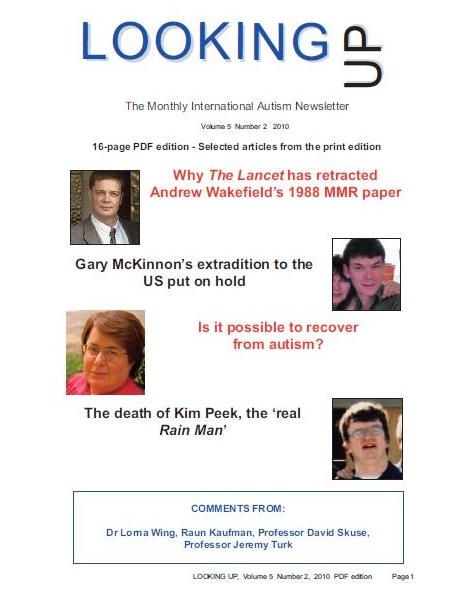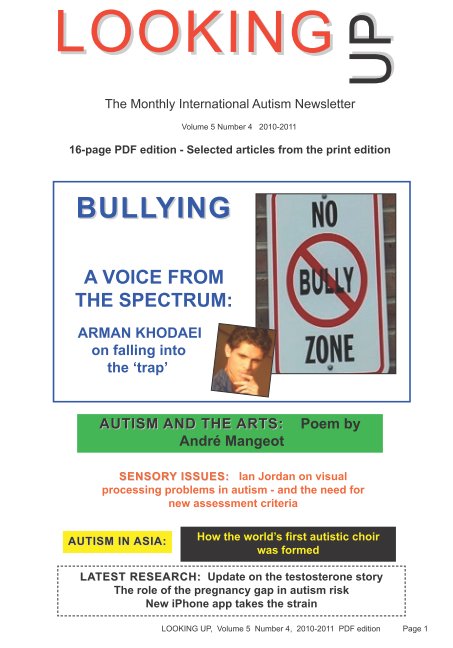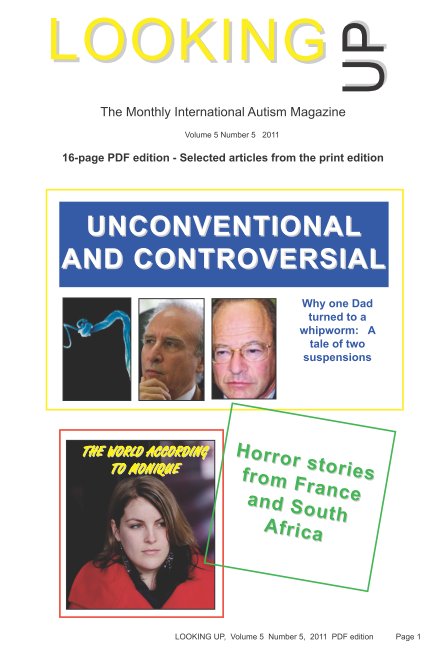Looking Up, 16-page English PDF Edition, Back Issues and Current Issue

|

|

|

|

|

|

|

|
| Home page | Subscribe (print edition) | Selected articles | Our publications | Our mailing lists |
| PDF edition | Subscribe (PDF edition) | Back issue contents | Autism books | Contact us |
From Volume 3 Number 6
THEO
PEETERS is the internationally respected director of the
Opleidingscentrum
Autisme (Centre for Training in Autism) in Antwerp, Belgium. He spoke
to Adam
Feinstein in Melbourne
ADAM
FEINSTEIN: One of the most striking
aspects of your work is an understanding that, just as we try and
comprehend
autistic children, they too are striving
to understand our world. Indeed, in Madrid a couple of years ago, you
pointed
out that we must try to look at the world through their eyes and their
minds.
Can you explain how this outlook colours your practical approach to
teaching
children with autism?
THEO PEETERS: That’s a very interesting question, and the answer is not brief or simple. If you look at autism from the outside and you remain an outsider, you may see many bizarre things: autistic children repeat things literally, they imitate our behaviours literally, they have repetitive behaviours, they make very concrete associations instead of thinking in a flexible way, they have difficulties in understanding our emotions. You may say, from time to time, that this child is being naughty: he doesn’t do what I ask him to do. But if you really try to get inside the child’s mind, to see the world through his eyes, you very often see that it is not that he does not want to do what you want but that he understands the world differently. He makes hypotheses. A normal child develops almost automatically according to theories which developmental psychologists like Jerome Bruner and Jean Piaget have developed. They even seem to have read the books! But children with autism do not develop that automatically. They test their own hypotheses. I am thinking, for example, about a certain child. When I gave him a rucksack, and when I asked him to go in a certain direction, he did this first and then developed a temper tantrum. In the beginning, as a professional who did not understand autism - I don’t understand it fully yet but I’ve learned a few things! - I wondered why the child was behaving that way. Didn’t he like me? Then I realised that the rucksack meant to him that he was going home. So we have to learn to understand each other. If children with autism can be echolalic - repeating our words literally - we must realise that, if we found ourselves stranded in another culture and tried to speak the way the locals do, without a manual, we would also tend to report things literally. There are many other examples. But what it all comes down to is that people with autism, in their own way, try to find meaning in life. And it’s not that easy for them. To help them, you enter their minds, see their obstacles and try and remove them. Theresa Jolliffe, a very high-functioning British woman with autism, describes the world in her autobiography as very chaotic. She says that most of the efforts in her life are directed at finding logic behind the chaos. If this is autism, then it has to be taken very seriously. Because as long as you are living in chaos, you do not have the energy to learn new things. You first need to have a little order. So in our educational approach, I put a lot of emphasis on what I call “pre-education.” That means trying to create conditions in which learning becomes possible. In a world in which everything seems to happen in a chaotic, coincidental way, we try to recreate meaning at a concrete and visual level: to give the child a kind of predictability in space and time. This is a very important first step in the development of independence: if you do not have the power of anticipation, everything seems dominated by coincidence.
ADAM
FEINSTEIN: So creating meaning out of
chaos is vital. Would you agree, therefore, with what the director of
TEACCH in
North Carolina, Gary Mesibov, told me last year: that one of the main
differences between the TEACCH method, which you espouse and use, and
the
ABA-Lovaas approach, for example, is that TEACCH’s primary aim is to
teach the
autistic child the meaning of the world?
THEO PEETERS: Yes. I really do not like approaches where they continue to look at children from the outside and try to make behaviours appear and disappear without really being interested in the child within.
ADAM
FEINSTEIN: Last year, I went to a
conference in Barcelona aimed at bridging the gap between educational
and
biomedical approaches to autism. Would you agree that it is very
important to
try and close this gap, which in some cases has become a chasm? Some
professionals see autism as an educational problem, while others insist
that
only a medical approach is valid. Do you agree that the two sides must
collaborate?
THEO PEETERS: Absolutely. I think the first approach is education, but from time to time medical interventions may be necessary. It is very important that the educational and medical worlds meet increasingly. I have written a book in which Christopher Gillberg talks about the biological and medical aspects of autism and I talk about the educational aspects. This was a very modest attempt to bring the two worlds together.
ADAM
FEINSTEIN: It is an excellent book. What
is your view on the supposed huge rise in autism? Do you think that it
is
largely due to improved diagnostic tools and a widening definition of
the
condition?
THEO PEETERS: First of all, I think it has to do do with the broadening definition of autism. We now have half a century of experience - especially with people who have a combination of autism and a learning disability, but we have also discovered that autism exists in high-functioning individuals, such as those with Asperger’s syndrome. The diagnostic centres today recognise the basic symptoms of deficits in social understanding and communication much better than before. There may be environmental factors involved in the rise in autism cases reported, but I am not a specialist in that area. By “environmental,” I do not mean the old idea about parents causing autism, but rather that there is so much poison in the environment that it is certainly imaginable that this could influence genetic aspects and life during pregnancy.
ADAM FEINSTEIN: Could there be a sub-type of autism, a regressive type possibly brought on by some environmental “insult to the brain, or vaccines?
THEO PEETERS: I do not know. But I do find this an intriguing question, because at the biological level, they may be finding more and more sub-types - but this also applies on the educational level. The big challenge in understanding autism in this new century will be to try to find correspondences between the medical and educational sub-types.
ADAM
FEINSTEIN: Apart from anything else,
this will help to integrate services for autistic children, won’t it?
THEO PEETERS. Yes. Also, it will help our understanding of the fact that each person with autism has his or own personality. Neurobiologists have been saying for years that autism is too general a concept, and they are talking increasingly about the biological syndromes of autism. But you could also talk about the educational syndromes of autism. And I am absolutely certain that, in the years to come, we will acquire a much more detailed knowledge of all aspects of autism.
ADAM
FEINSTEIN: Some professionals are making
very optimistic noises about the chances of a cure coming a lot closer
with
advances emerging from research.
THEO PEETERS: Well, there really is a lot of research going on in this field. And what Eric Courchesne, for instance, has been saying here in Melbourne about his brain-size study is very important and hopeful.
ADAM
FEINSTEIN: Autism has been referred to
by some as a different “culture.” Could you explain what they might
mean by
this?
THEO PEETERS: When I deal with professionals who are just starting out, I always tell them: the most important aspect in training is not applying recipes but trying to adopt “autism thinking.” Because people with autism think differently and also are different. And when you listen to people with very high-functioning autism, like Jim Sinclair or Claire Sainsbury, they very often use the analogy of a different culture. Sometimes I say, rather ironically, that what we need is not more psychologists but more anthropologists who have learned to look at other cultures without prejudices. We need each other: people with autism need us because they have to learn about our culture or behaviour. But if we want to understand autism better, we need much closer collaboration with people who understand autism from within - that is, the people with autism themselves. So I really feel we are entering a new era in which at least some people with autism will be our collaborators. We have to learn to respect each other.

|

|

|

|

|

|

|

|
| Current 40-page print edition issue | |||||||||||||||
|---|---|---|---|---|---|---|---|---|---|---|---|---|---|---|---|

|
| ||||||||||||||
| PRINT EDITION BACK ISSUE CONTENTS AND FRONT COVERS | ||||||||||||||||||||||||||
|---|---|---|---|---|---|---|---|---|---|---|---|---|---|---|---|---|---|---|---|---|---|---|---|---|---|---|
| VOLUME 1, Number: | 1 | 2 | 3 | 4 | 5 | 6 | 7 | 8 | 9 | 10 | 11 | 12 | VOLUME 2, Number: | 1 | 2 | 3 | 4 | 5 | 6 | 7 | 8 | 9 | 10 | 11 | 12 | |
| VOLUME 3, Number: | 1 | 2 | 3 | 4 | 5 | 6 | 7 | 8 | 9 | 10 | 11 | 12 | VOLUME 4, Number: | 1 | 2 | 3 | 4 | 5 | 6 | 7 | 8 | 9 | 10 | 11 | 12 | |
| VOLUME 5, Number: | 1 | 2 | 3 | 4 | 5 | 6 | 7 | 8 | ||||||||||||||||||
| You can find our PDF EDITION CONTENTS AND COVERS on our PDF EDITION BACK ISSUES PAGE | ||||||||||||||||||||||||||
| Home page | Subscribe (print edition) | Selected articles | Our publications | Our mailing lists |
| PDF edition | Subscribe (PDF edition) | Back issue contents | Autism books | Contact us |